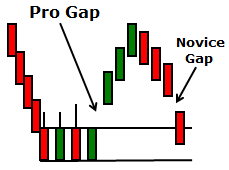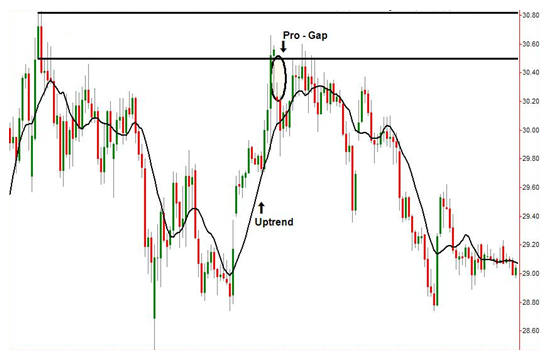![]()
Novice gaps are the ultimate picture of novice greed in the market. Why do I make gaps such an important part of the XLT program? Simple, because gaps are the most obvious way to spot a novice market speculator, which is exactly who you want on the other side of your trade. Remember, if you can’t spot the novice, consistent losing trader in a market, the novice trader is probably you. Just like the game of poker. If you sit down at the table and can’t figure out quickly who will pay the table that night, it is likely you.
Gaps in price are great because they are both the picture of a strong supply and demand imbalance and the picture of confusion, greed, and fear when you understand them. Not every gap sends the same message or represents the same opportunity so we structure them into an understandable check list. Once this is done, we can use this information to spot the picture of very novice buying or selling and be there to take the low risk, high reward, and high probability trade.
In the XLT, we cover two types of gaps specifically, Novice and Pro gaps. Both offer strong opportunities when present in a market so let’s go over them. The illustration above shows these two types of gaps, let’s go over them in more detail.
The Novice Gap: The novice gap is a gap in price, after a move in price, in the same direction as that move.
The Novice Gap Logic: The buyer of a novice gap up (buying after a strong period of buying) or a the seller of a novice gap down (selling after a strong period of selling) is considered novice because only a novice trader would take that very low probability action.
The Novice Gap Entry: When the novice gap is into a fresh demand or supply zone, we enter the position in the opposite direction of the gap (fade the gap).
Pro Gap: The pro gap is a gap in price, after a move in price, in the opposite direction of that move.
The Pro Gap Logic: Just as the novice gap clearly shows the foot prints of novice trading action, the pro gap equally conveys the message of professional buying or selling. Bank or institutions have buying and selling power to cause a pro gap, not retail traders.
The Pro Gap Entry: The entry for this setup is on the first retracement to the origin of the gap, in the same direction of the gap.
Above is an example of a Pro Gap down. Notice the uptrend that ends at an area of supply. While the pivot to the far left of the chart is not a quality supply level, the Pro Gap down in the middle of the chart certainly is. Our entry is to short a rally back to the origin of that gap down. This entry is a favorite among XLT members along with the Novice Gap. The logic again is that institution size accounts can halt the uptrend and cause price to gap down, against the prevailing trend. Therefore, by entering short on the first retracement, we are entering with the institution. Our goal in trading is not to create certainty because that never exists. Our goal is to become masters at objectively assessing the odds which means objectively quantifying real supply and demand and that is what we did.
Let’s get back to gaps… In the XLT, we keep it simple, here are some more thoughts to keep in mind when you have a gap:
1) A gap up in price, into supply, after a rally in price, and in the context of a larger time frame down trend is a VERY high odds shorting opportunity.
2) A gap up in price, in the context of an uptrend is a lower odds shorting opportunity and actually can be a buying opportunity on a pullback to demand when there is a significant profit margin above.
3) A gap down in price, into demand, after a decline in price, and in the context of a larger time frame uptrend is a VERY high odds buying opportunity.
4) A gap down in price , in the context of a downtrend is a lower odds buying opportunity and may in some cases be a shorting opportunity after a rally into supply when there is a significant profit margin below.
While there is much more on gaps than I can’t write about in a short piece such as this one, keep in mind that the picture of the ultimate supply and demand imbalance is a gap. When you are ready to take a trade, simply ask yourself, “Who is on the other side of my trade?” and make sure you are trading with someone who is making a big mistake according to the laws of supply and demand, motion into mass, or whatever version of this basic governing dynamic you want to call it. Instead of looking at red and green candles on a chart and following a conventional Technical Analysis book, start looking a little deeper and begin to understand the order flow that’s going on behind the scenes that is responsible for the creation of those candles. These basic thoughts will likely give you an edge over those who are on the other side of your trades and having that edge is the key to trading anything. If you are tired of transferring your account into someone else’s, stop looking at the market the same way everyone else does.
Hope this was helpful. Have a great day.
Note: All information on this page is subject to change. The use of this website constitutes acceptance of our user agreement. Please read our privacy policy and legal disclaimer. Opinions expressed at FXstreet.com are those of the individual authors and do not necessarily represent the opinion of FXstreet.com or its management. Risk Disclosure: Trading foreign exchange on margin carries a high level of risk, and may not be suitable for all investors. The high degree of leverage can work against you as well as for you. Before deciding to invest in foreign exchange you should carefully consider your investment objectives, level of experience, and risk appetite. The possibility exists that you could sustain a loss of some or all of your initial investment and therefore you should not invest money that you cannot afford to lose. You should be aware of all the risks associated with foreign exchange trading, and seek advice from an independent financial advisor if you have any doubts.
Editors’ Picks
USD/JPY crashes nearly 450 pips to 155.50 on likely Japanese intervention

Having briefly recaptured 160.00, USD/JPY came under intense selling to test 155.00 on what seems like a Japanese FX intervention underway. The Yen tumbled in early trades amid news that Japan's PM lost 3 key seats in the by-election. Holiday-thinned trading exaggerates the USD/JPY price action.
AUD/USD rallies toward 0.6600 on risk flows, hawkish RBA expectations

AUD/USD extends gains toward 0.6600 in the Asian session on Monday. The Aussie pair is underpinned by increased bets of an RBA rate hike at its May policy meeting after the previous week's hot Australian CPI data. Risk flows also power the pair's upside.
Gold tests critical daily support line, will it defend?

Gold price is seeing a negative start to a new week on Monday, having booked a weekly loss. Gold price bears the brunt of resurgent US Dollar (USD) demand and a risk-on market mood amid Japanese holiday-thinned market conditions.
Ethereum fees drops to lowest level since October, ETH sustains above $3,200

Ethereum’s high transaction fees has been a sticky issue for the blockchain in the past. This led to Layer 2 chains and scaling solutions developing alternatives for users looking to transact at a lower cost.
Week ahead: Hawkish risk as Fed and NFP on tap, Eurozone data eyed too

Fed meets on Wednesday as US inflation stays elevated. Will Friday’s jobs report bring relief or more angst for the markets? Eurozone flash GDP and CPI numbers in focus for the Euro.
RECOMMENDED LESSONS
Making money in forex is easy if you know how the bankers trade!
Discover how to make money in forex is easy if you know how the bankers trade!
5 Forex News Events You Need To Know
In the fast moving world of currency markets, it is extremely important for new traders to know the list of important forex news...
Top 10 Chart Patterns Every Trader Should Know
Chart patterns are one of the most effective trading tools for a trader. They are pure price-action, and form on the basis of underlying buying and...
7 Ways to Avoid Forex Scams
The forex industry is recently seeing more and more scams. Here are 7 ways to avoid losing your money in such scams: Forex scams are becoming frequent. Michael Greenberg reports on luxurious expenses, including a submarine bought from the money taken from forex traders. Here’s another report of a forex fraud. So, how can we avoid falling in such forex scams?
What Are the 10 Fatal Mistakes Traders Make
Trading is exciting. Trading is hard. Trading is extremely hard. Some say that it takes more than 10,000 hours to master. Others believe that trading is the way to quick riches. They might be both wrong. What is important to know that no matter how experienced you are, mistakes will be part of the trading process.



